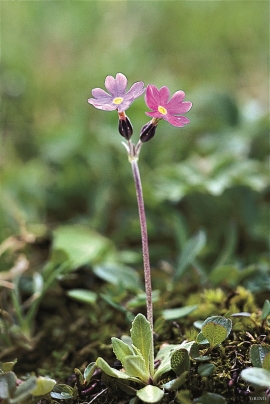Published: 06.09.2015 | Author: Haakon Fossen, Bjørn Moe
A syncline is formed when the rock layers are bowed into a trough-shaped structure. Vesoldo is the bottom of a giant syncline. Here, the mountain seen from the northeast. (Svein Nord)
THE GIANT FOLD
Folds are to be found everywhere in the remains of the Caledonian mountain chain. Some were formed during the collision with Greenland, others stem from the time when the mountain chain collapsed. Few can compare with the giant fold that remains in the mountain area around Tørvikenuten, Vesoldo and Hellefjellet.
This mountain area rises high in the landscape between Norheimsund and Strandebarm. Two tops stand out in particular. Vesoldo (1046 mas.) and Tørvikenuten (1028 mas.). Especially from the north these tops show how the bedrock layers were formed like a trough. The trough-form is accentuated by the layers of rhyolite (metamorphosed acidic lava flows) and sandstone that are squeezed between the greenschist and mica schist.
All of these rocks are from the Cambro-Silurian, from the time before the mountain-building began. During the collision with Greenland, they were altered and kneaded as the collision transported them from an unknown place far to the west of Hardanger. During this process the bedrock became layered and schistose, as on Mt. Hellefjellet. After the collision was over, the Cambro-Silurian bedrocks sank several kilometres back toward the west. It was then, early in the Devonian Period, that the giant fold was formed, at 10–15 kilometres depth.
Where the Cambro-Silurian bedrocks lie high up, they give good growing conditions for a number of alpine plants. Vesoldo and Tørvikeknuten are among the richest plant-mountains on the north side of Hardanger Fjord. Many finicky alpine plants grow in this nutrient-rich mineral soil, such as mountain avens, dwarf willow, rocky sedge, scorched alpine sedge, moss campion and alpine cinqeufoil. Some of the species, such as Primula scandinavica and alpine milk vetch, have an easterly distribution and are especially rare in this part of the county.
- Kvale, A. Petrologic and structural studies in the Bergsdalen quadrangle, western Norway. Bergen Museums Årbok 1946–47, Naturvit.rekke,1.
- Ragnhildstveit, J.; Helliksen, D. 1997. Geologisk kart over Norge, berggrunnskart Bergen – M 1:250.000. Norges geologiske undersøkelse.




